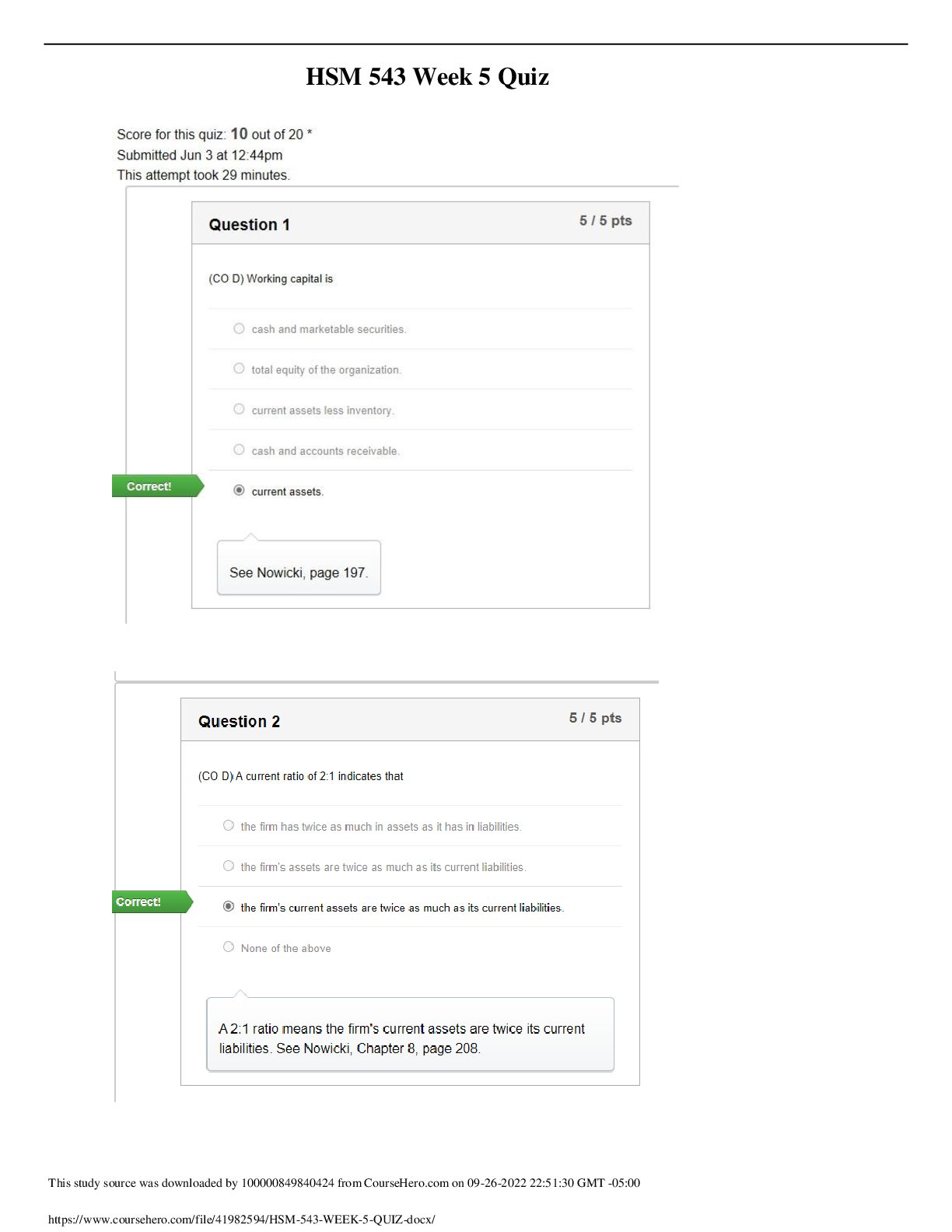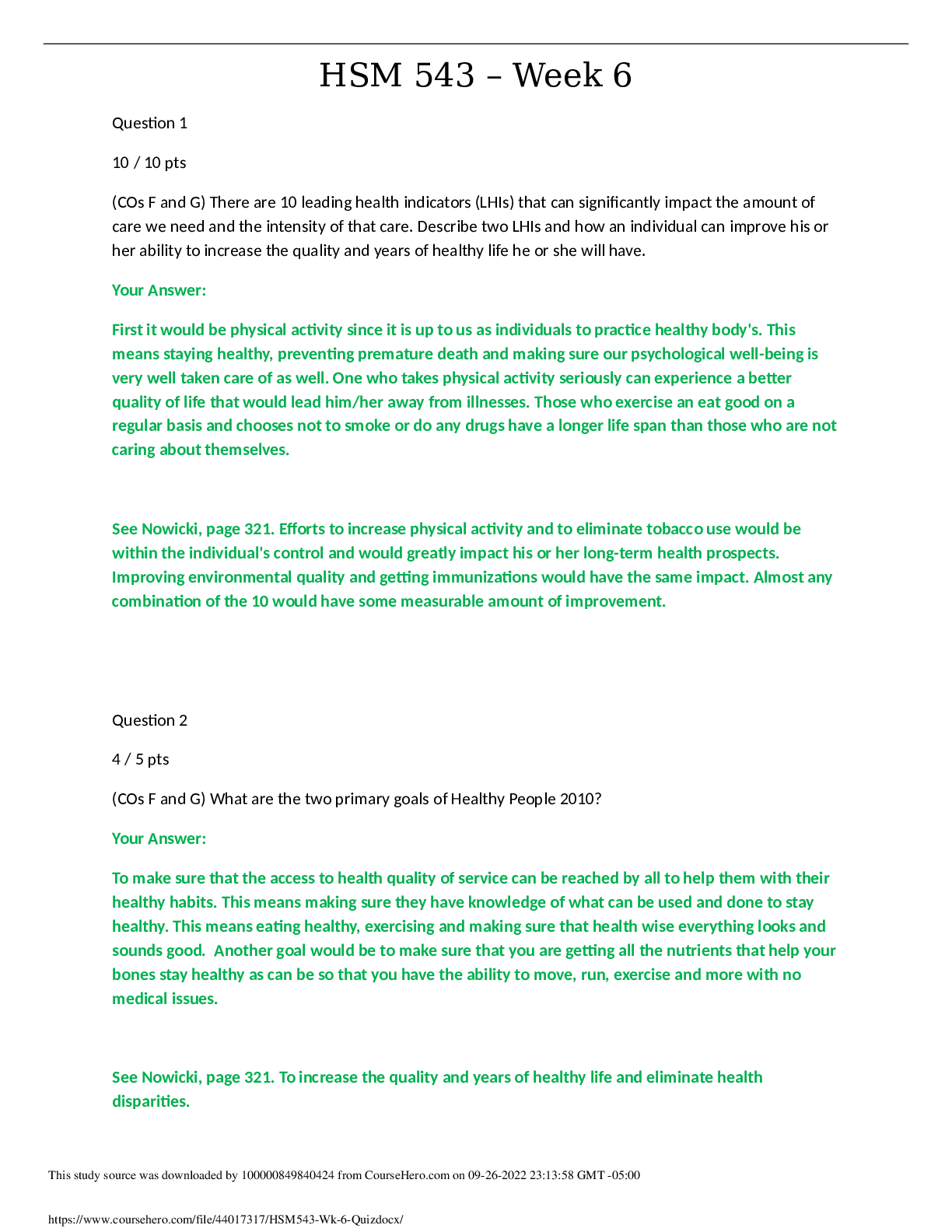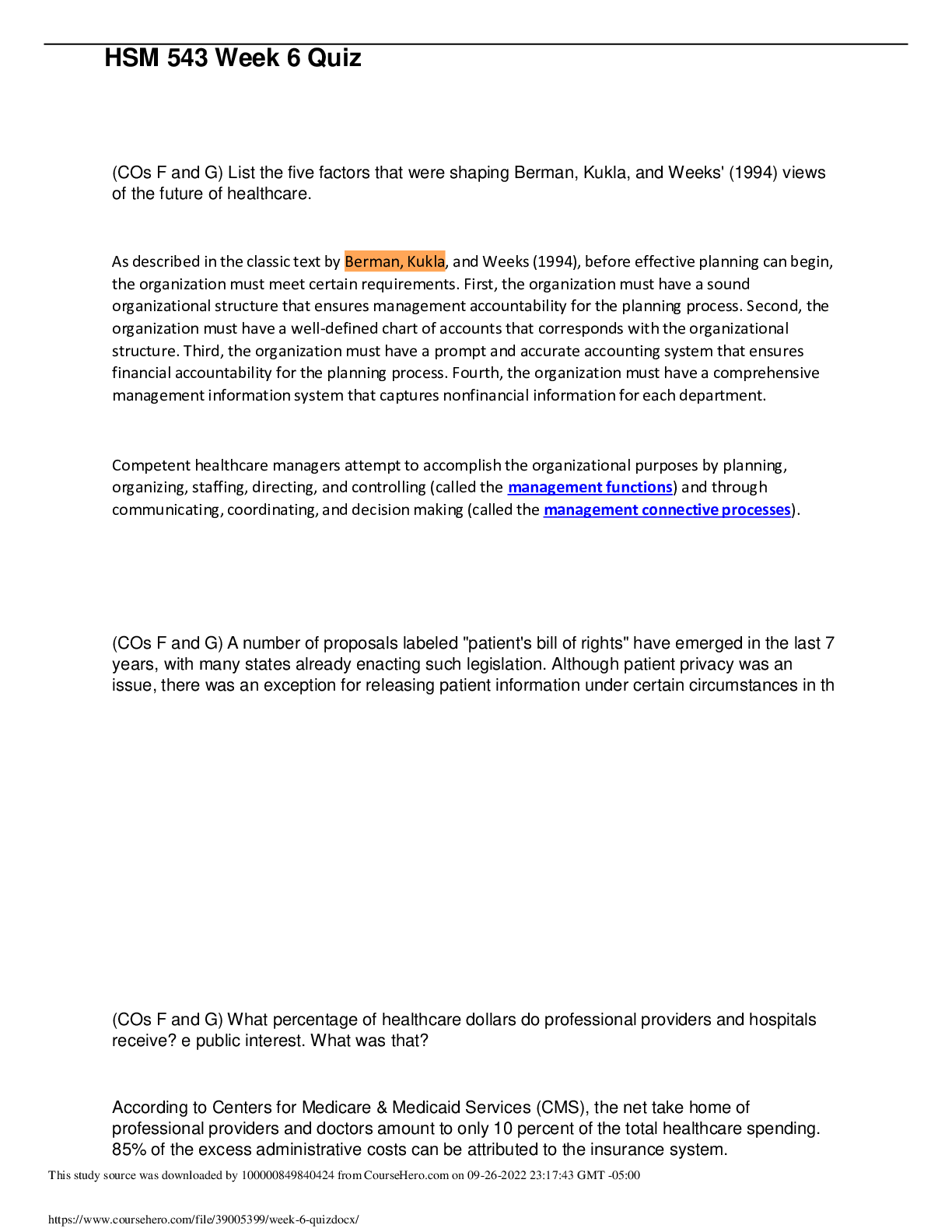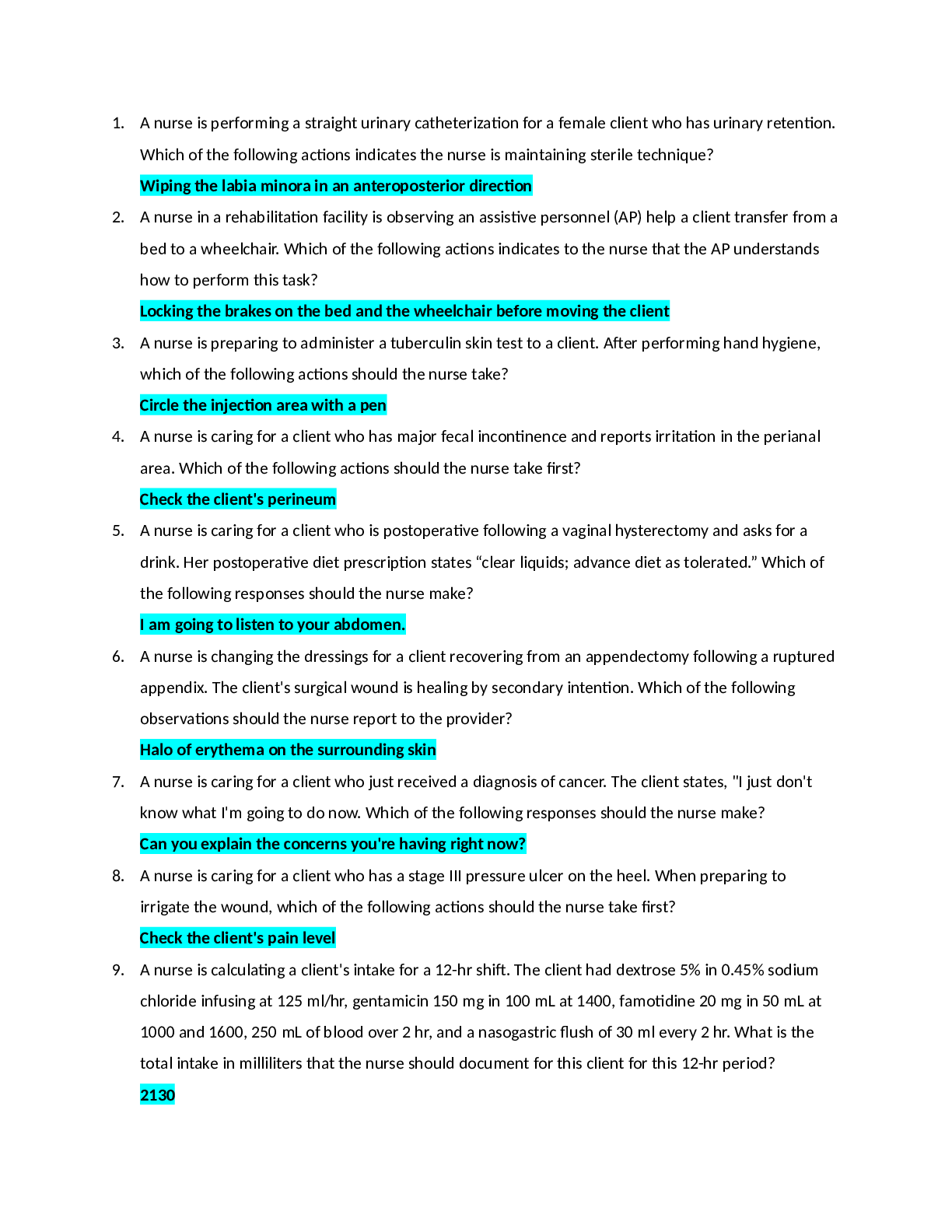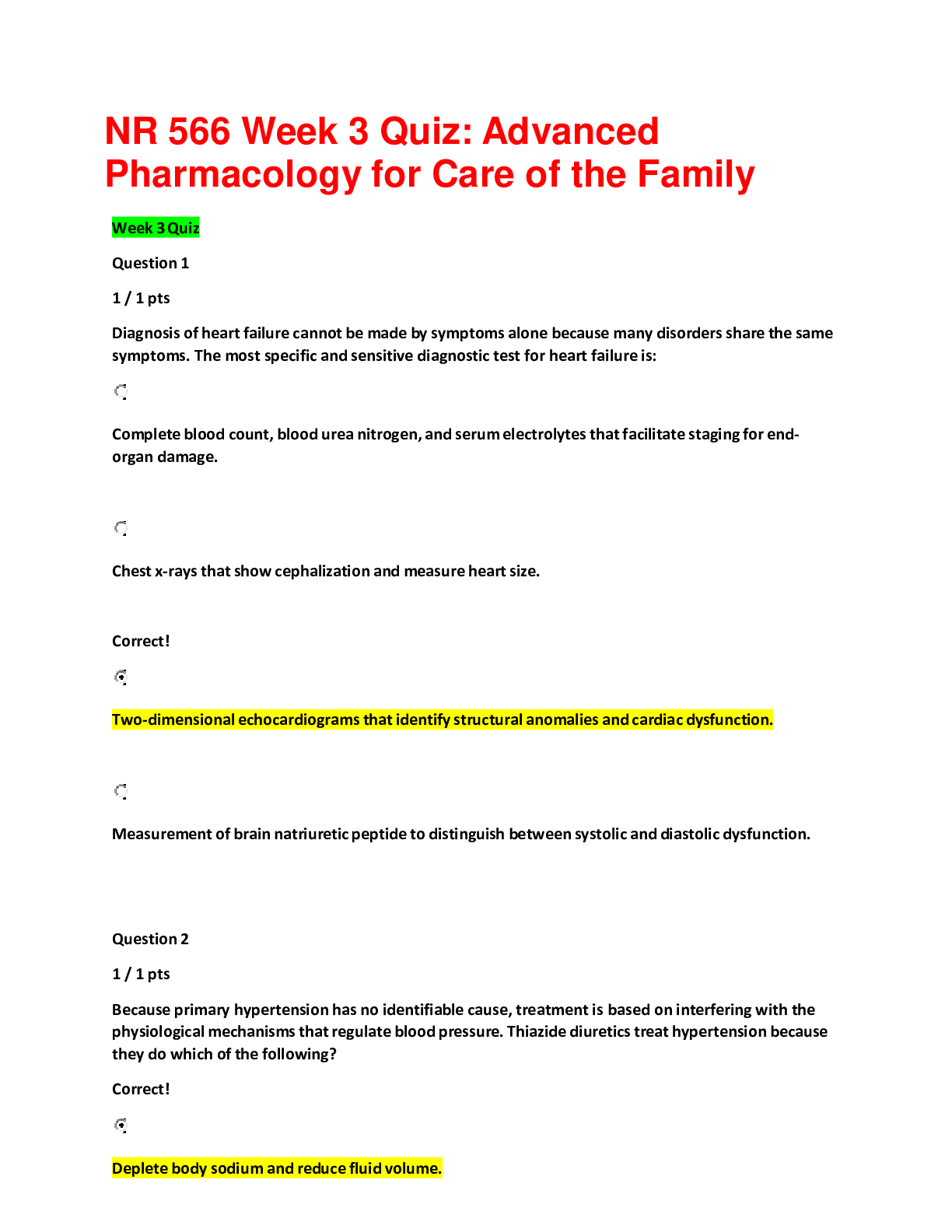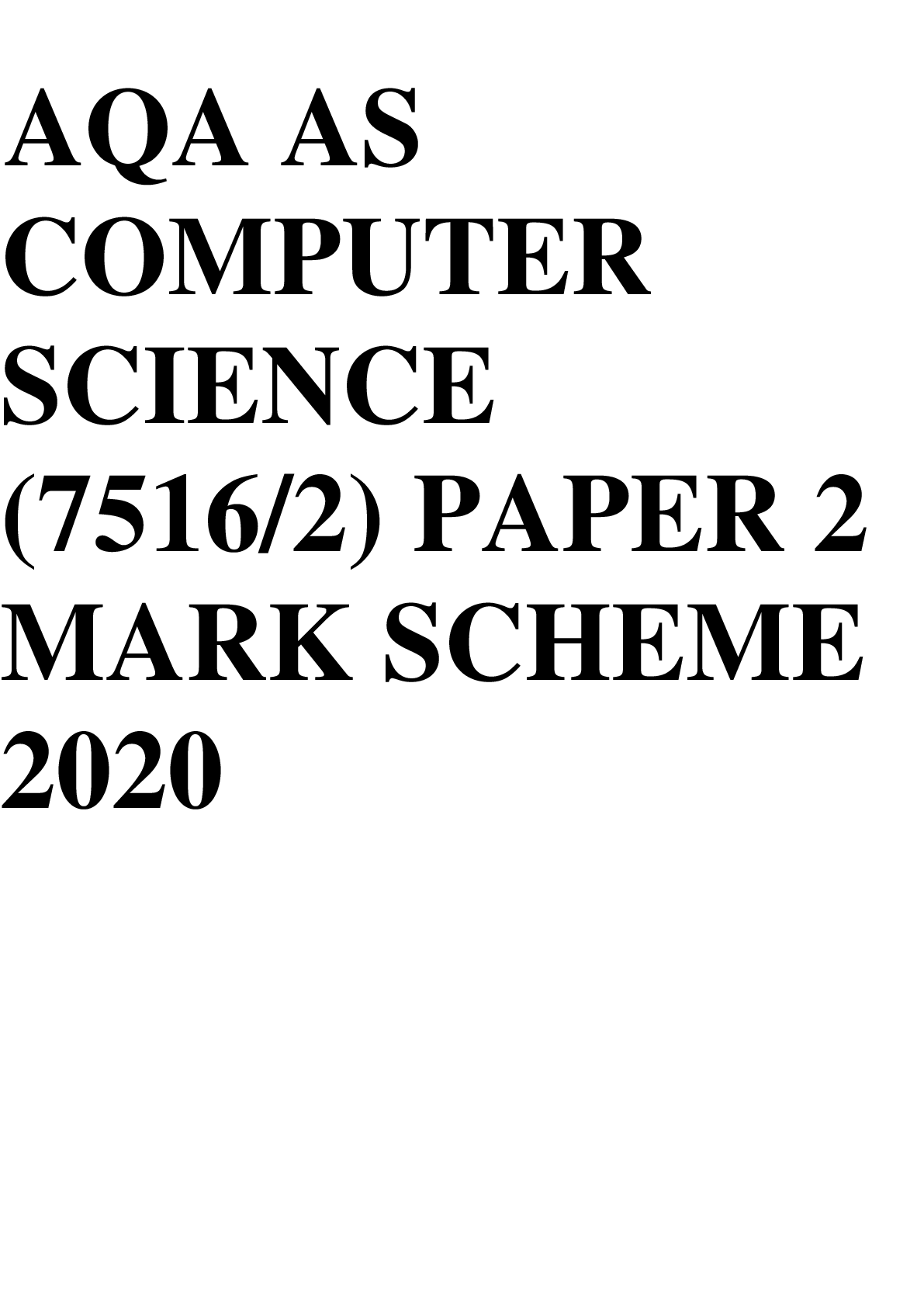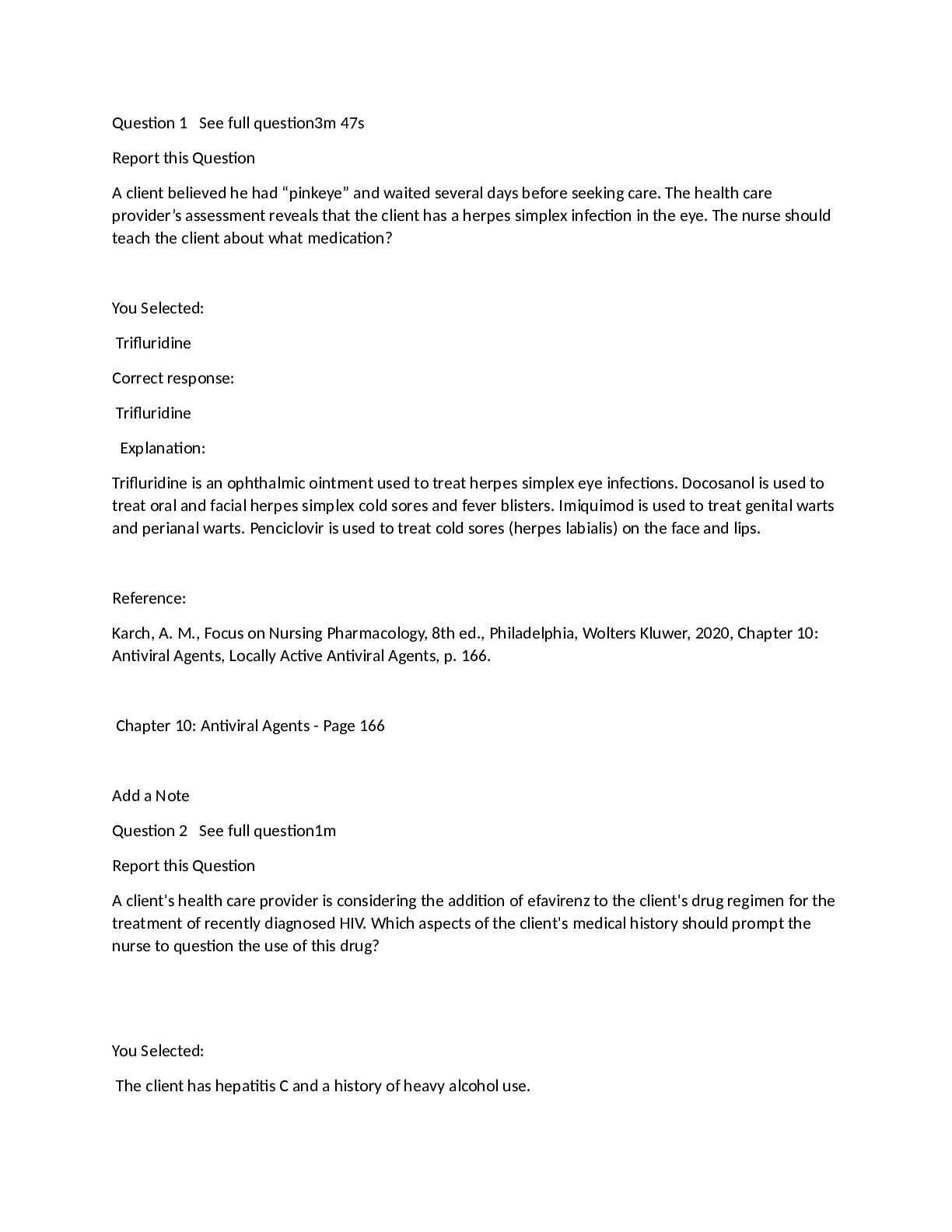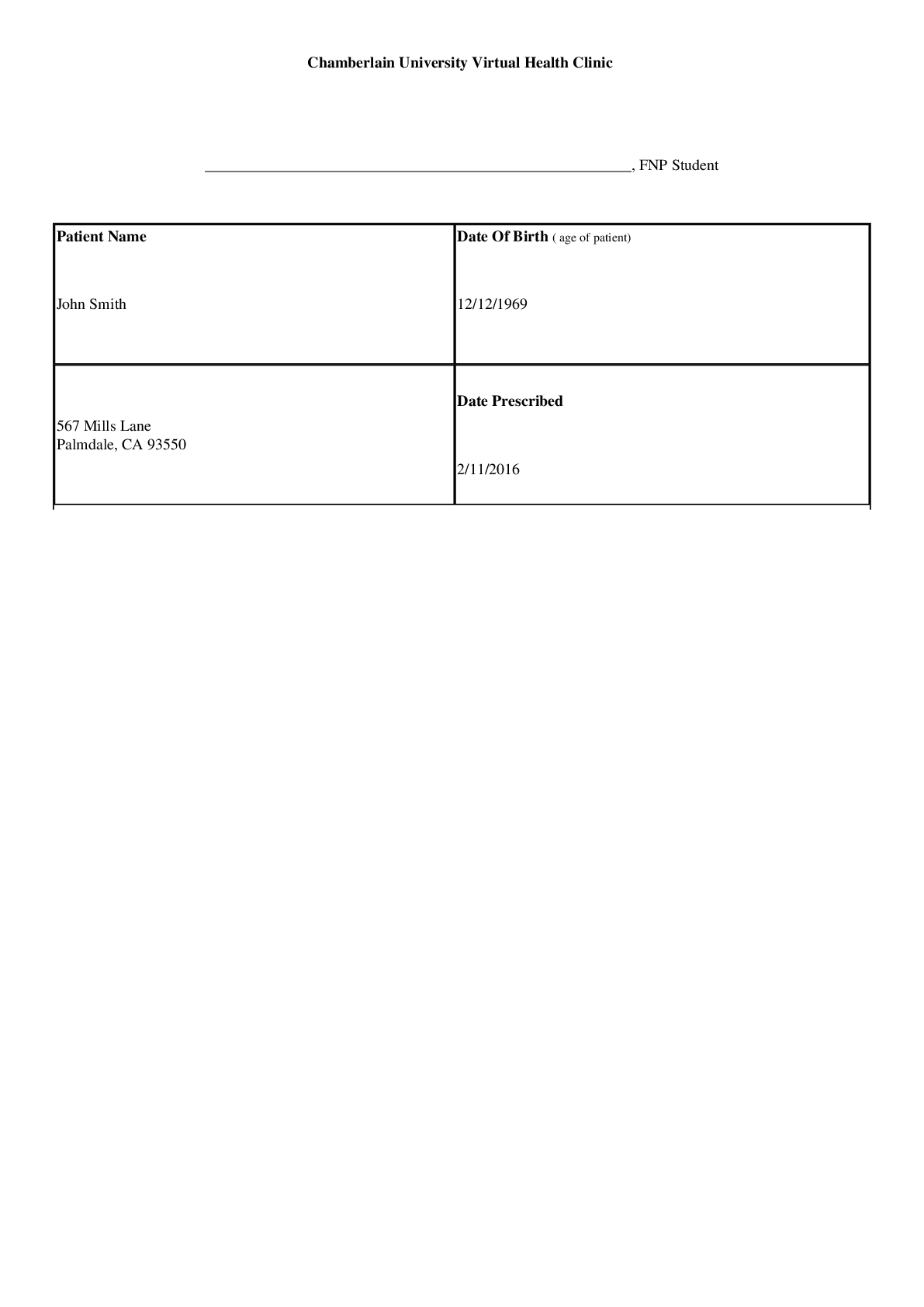*NURSING > EXAM > NURS-6512N Midterm (Completed) | Score 98 out of 100 | Download To Score An A (All)
NURS-6512N Midterm (Completed) | Score 98 out of 100 | Download To Score An A
Document Content and Description Below
Course NURS-6512N-,Advanced Health Assessment. Status Completed Attempt Score 98 out of 100 points Time Elapsed 1 hour, 27 minutes out of 2 hours Instructions Please answer eac... h question below and click Submit when you have completed the Exam. Results Displayed Submitted Answers, Incorrectly Answered Questions • Question 1 1 out of 1 points To perform the Rinne test, place the tuning fork on the: Selected Answer: mastoid bone. • Question 2 1 out of 1 points You are examining a pregnant patient and have noted a vascular lesion. When you blanche over the vascular lesion, the site blanches and refills evenly from the center outward. The nurse documents this lesion as a: Selected Answer: B. spider angioma. • Question 3 1 out of 1 points When palpating the abdomen, you should note whether the liver is enlarged in the: Selected Answer: right upper quadrant. • Question 4 1 out of 1 points Mr. Kevin Marks is a new health care provider. What is the best method to develop cultural competence? Selected Answer: Realize that cultural values are difficult to change and must be respected. • Question 5 1 out of 1 points The review of systems is a component of the: Selected Answer: health history. • Question 6 1 out of 1 points You are planning to palpate the abdomen of your patient. Which part of the examiner's hand is best for palpating vibration? Selected Answer: Ulnar surface • Question 7 1 out of 1 points You are completing a general physical examination on Mr. Rock, a 39-year-old man with complaints of constipation. When examining a patient with tense abdominal musculature, a helpful technique is to have the patient: Selected Answer: flex his or her knees. • Question 8 1 out of 1 points Mrs. Britton is a 34-year-old patient who presents to the office with complaints of skin rashes. You have noted a 4' 3-cm, rough, elevated area of psoriasis. This is an example of a: Selected Answer: A. plaque. • Question 9 1 out of 1 points When taking a history, you should: Selected Answer: use a chronologic and sequential framework. • Question 10 1 out of 1 points In examining the neck of a 34-year-old female patient, you note that the uppermost ridge of the tracheal cartilage is at the: Selected Answer: cricoid. • Question 11 1 out of 1 points When recording physical findings, which data are recorded first for all systems? Selected Answer: Inspection • Question 12 1 out of 1 points The infant should be placed in which position to have his or her height or length measured? Selected Answer: Supine on a measuring board • Question 13 1 out of 1 points During an interview, tears appear in the patient's eyes and his voice becomes shaky. Initially, you should: Selected Answer: offer a tissue and let him know it is all right to cry. • Question 14 1 out of 1 points Which of the following is the most accurate reflection of an individual's food intake? Selected Answer: Food diary • Question 15 1 out of 1 points Your patient is complaining of acute, intense sharp epigastric pain that radiates to the back and left scapula with nausea and vomiting. Based on this history, your prioritized physical examination should be to: Selected Answer: inspect for ecchymosis of the flank. • Question 16 1 out of 1 points Mr. Williams, age 25, has recovered recently from an upper and lower respiratory infection. He describes a long-standing nasal dripping. He is seeking treatment for a mild hearing loss that has not gone away. Information concerning his chronic postnasal drip should be documented within which section of his history? Selected Answer: Past medical data • Question 17 1 out of 1 points A 51-year-old woman calls with complaints of weight loss and constipation. She reports enlarged hemorrhoids and rectal bleeding. You advise her to: Selected Answer: come to the laboratory for a stool guaiac test. • Question 18 1 out of 1 points A serous membrane that lines the abdominal cavity and forms a protective cover for many abdominal structures is the: Selected Answer: peritoneum. • Question 19 1 out of 1 points Which of the following is the most vital nutrient? Selected Answer: Water • Question 20 1 out of 1 points Peritonitis produces bowel sounds that are: Selected Answer: hypoactive. • Question 21 1 out of 1 points When are open-ended questions generally most useful? Selected Answer: During the initial part of the interview • Question 22 1 out of 1 points Percussing at the right midclavicular line, below the umbilicus, and continuing upward is the correct technique for locating the: Selected Answer: lower liver border. • Question 23 1 out of 1 points Mrs. G. reports an increase in her alcohol intake over the past 5 years. To screen her for problem drinking, you would use the: Selected Answer: CAGE questionnaire. • Question 24 1 out of 1 points During percussion, a dull tone is expected to be heard over: Selected Answer: the liver. • Question 25 1 out of 1 points The attitudes of the health care professional: Selected Answer: are culturally derived. • Question 26 1 out of 1 points Spasmodic muscular contractions of the head, face, or neck are called: Selected Answer: B. tics. • Question 27 1 out of 1 points When communicating with older children and teenagers, you should be sensitive to their: Selected Answer: typical reluctance to talk. • Question 28 1 out of 1 points Ms. Davis is a 27-year-old patient with a BMI of 33. Based on her BMI, your diagnosis would be: Selected Answer: obese. • Question 29 1 out of 1 points In counseling a client regarding nutrition education, you explain that linoleic acid, a major fatty acid, is thought to be essential for: Selected Answer: normal growth and development. • Question 30 0 out of 1 points Recommended carbohydrate content of total dietary intake (% total calories) is %. Selected Answer: fifty percent • Question 31 1 out of 1 points The adult recommended dietary fat intake should be g/day. Selected Answer: 20 to 35 • Question 32 1 out of 1 points Peritonitis produces bowel sounds that are: Selected Answer: hypoactive. • Question 33 1 out of 1 points Tracheal tug suggests the presence of a(n): Selected Answer: aortic aneurysm. • Question 34 1 out of 1 points When hearing is evaluated, which cranial nerve is being tested? Selected Answer: VIII • Question 35 1 out of 1 points Mrs. Raymonds is a 24-year-old patient who has presented for a routine concern over her current weight. In your patient teaching with her, you explain the importance of macronutrients. Which of the following is a macronutrient? Selected Answer: Fat • Question 36 1 out of 1 points Mr. Franklin is speaking with you, the health care provider, about his respiratory problem. Mr. Franklin says, "I've had this cough for 3 days, and it's getting worse." You reply, "Tell me more about your cough." Mr. Franklin states, "I wish I could tell you more. That's why I'm here. You tell me what's wrong!" Which caregiver response would be most appropriate for enhancing communication? Selected Answer: After 3 days, you're tired of coughing. Have you had a fever? • Question 37 1 out of 1 points Which technique is most likely to result in the patient's understanding of questions? Selected Answer: Use the patient's own terms if possible. • Question 38 1 out of 1 points Sweat glands, hair, and nails are all formed from: Selected Answer: C. invaginations of epidermis into dermis. • Question 39 1 out of 1 points During physical examination of a 30-year-old Chinese man, you notice slight asymmetry of his face. The cranial nerve examination is normal. Your best action is to: Selected Answer: D. record the finding in the patient’s chart. • Question 40 1 out of 1 points The position on a clock, topographic notations, and anatomic landmarks: Selected Answer: are methods for recording locations of findings. • Question 41 1 out of 1 points Expected hair distribution changes in older adults include: Selected Answer: increased terminal hair follicles to the tragus of men’s ears. • Question 42 1 out of 1 points Your patient is complaining of acute, intense sharp epigastric pain that radiates to the back and left scapula with nausea and vomiting. Based on this history, your prioritized physical examination should be to: Selected Answer: inspect for ecchymosis of the flank. • Question 43 1 out of 1 points A fixed image of any group that rejects its potential for originality or individuality is known as a(n): Selected Answer: stereotype. • Question 44 1 out of 1 points Nasal symptoms that imply an allergic response include: Selected Answer: bluish gray turbinates. • Question 45 1 out of 1 points As you explain your patient's condition to her husband, you notice that he is leaning toward you and pointedly blinking his eyes. Knowing that he is from England, your most appropriate response to this behavior is to: Selected Answer: ask whether he has any questions. • Question 46 1 out of 1 points Periods of silence during the interview can serve important purposes, such as: Selected Answer: providing time for reflection. • Question 47 1 out of 1 points Mr. Donalds is a 45-year-old roofer. Your inspection to determine color variations of the skin is best conducted: Selected Answer: C. with illumination provided by daylight. • Question 48 1 out of 1 points Mr. L. presents to the clinic with severe groin pain and a history of kidney stones. Mr. L.'s son tells you that, for religious reasons, his father wishes to keep any stone that is passed into the urine filter that he has been using. What is your most appropriate response? Selected Answer: "With your father's permission, we will examine the stone and request that it be returned to him." • Question 49 1 out of 1 points Tangential lighting is best used for inspecting skin: Selected Answer: contour. • Question 50 1 out of 1 points Ms. G. is being seen for her routine physical examination. She is a college graduate and president of a research firm. Although her exact salary is unknown, she has adequate health insurance. Most of the above information is part of Ms. G.'s history. Selected Answer: personal and social • Question 51 1 out of 1 points Coarse, dry, and brittle hair is associated with which metabolic disorder? Selected Answer: Hypothyroidism • Question 52 1 out of 1 points What finding is unique to the documentation of a physical examination of an infant? Selected Answer: Fontanel sizes • Question 53 1 out of 1 points A 17-year-old girl presents to the clinic for a sports physical. Physical examination findings reveal bradycardia, multiple erosions of tooth enamel, and scars on her knuckles. She appears healthy otherwise. You should ask her if she: Selected Answer: binges and vomits. • Question 54 1 out of 1 points Mr. Black is a 44-year-old patient who presents to the clinic with complaints of neck pain that he thinks is from his job involving computer data entry. As the examiner, you are checking the range of motion in his neck and note the greatest degree of cervical mobility is at: Selected Answer: D. C4 to C5. • Question 55 1 out of 1 points Bulging of an amber tympanic membrane without mobility is most often associated with: Selected Answer: middle ear effusion. • Question 56 1 out of 1 points Mrs. Webb is a 38-year-old patient who has been changing her lifestyle to eat in a healthy way and lose weight. During your health promotion education regarding her nutritional status, you explain the function of dietary protein as: Selected Answer: building and maintaining tissues. • Question 57 1 out of 1 points Mr. D. complains of a headache. During the history, he mentions his use of alcohol and illicit drugs. This information would most likely belong in the: Selected Answer: personal and social history. • Question 58 1 out of 1 points Underestimation of blood pressure will occur if the blood pressure cuff's width covers: Selected Answer: more than two-thirds of the upper arm. • Question 59 1 out of 1 points Which of the following formats would be used for visits that address problems not yet identified in the problem-oriented medical record (POMR)? Selected Answer: Brief SOAP note • Question 60 1 out of 1 points Differential diagnoses belong in the: Selected Answer: assessment. • Question 61 1 out of 1 points Which statement is true regarding the relationship of physical characteristics and culture? Selected Answer: There is a difference between distinguishing cultural characteristics and distinguishing physical characteristics. • Question 62 1 out of 1 points Which cranial nerves innervate the face? Selected Answer: C. V and VII • Question 63 1 out of 1 points In issues surrounding ethical decision making, beneficence refers to the: Selected Answer: need to do good for the patient. • Question 64 1 out of 1 points Small, minute bruises are called: Selected Answer: petechiae. • Question 65 0 out of 1 points The recommended minimum daily protein requirement for the normal adult is . Selected Answer: 14% to 20% • Question 66 1 out of 1 points When you are questioning a patient regarding alcohol intake, she tells you that she is only a social drinker. Which initial response is appropriate? Selected Answer: "What amount and what kind of alcohol do you drink in a week?" • Question 67 1 out of 1 points A brief statement of the reason the patient is seeking health care is called the: Selected Answer: chief complaint. • Question 68 1 out of 1 points You are using an ophthalmoscope to examine a patient's inner eye. You rotate the lens selector clockwise, then counterclockwise to compensate for: Selected Answer: myopia. • Question 69 1 out of 1 points Which of the following organs is part of the alimentary tract? Selected Answer: Stomach • Question 70 1 out of 1 points Mr. Walters, a 32-year-old patient, tells you that his ears are "stopped up." An objective assessment of this complaint is achieved by using the: Selected Answer: tympanometer. • Question 71 1 out of 1 points A 5-year-old child presents with nasal congestion and a headache. To assess for sinus tenderness you should palpate over the: Selected Answer: maxillary sinuses only. • Question 72 1 out of 1 points Which is the best way to position a patient's neck for palpation of the thyroid? Selected Answer: C. Flexed toward the side being examined • Question 73 1 out of 1 points Regardless of the origin, discharge is described by noting: Selected Answer: color and consistency. • Question 74 1 out of 1 points During an interview, you have the impression that a patient may be considering suicide. Which action is essential? Selected Answer: Ask whether the patient has considered self-harm. • Question 75 1 out of 1 points The term denoting the caregiver's need to do no harm to the patient is: Selected Answer: nonmaleficence. • Question 76 1 out of 1 points To approximate vocal frequencies, which tuning fork should be used to assess hearing? Selected Answer: 500 to 1000 Hz • Question 77 1 out of 1 points Mr. Sanchez is a 45-year-old gentleman who has presented to the office for a physical examination to establish a new primary care health care provider. Which of the following describes a physical, not a cultural, differentiator? Selected Answer: Race • Question 78 1 out of 1 points Mr. Abdul is a 40-year-old Middle Eastern man who presents to the office for a first visit with the complaint of new abdominal pain. You are concerned about violating a cultural prohibition when you prepare to do his rectal examination. The best tactic would be to: Selected Answer: inform the patient of the reason for the examination and ask if it is acceptable to him. • Question 79 1 out of 1 points Inspection of the abdomen should begin with the patient supine and the examiner: Selected Answer: seated on the patient's right. • Question 80 1 out of 1 points A tool used to screen adolescents for alcoholism is the: Selected Answer: CRAFFT. • Question 81 1 out of 1 points Before performing an abdominal examination, the examiner should: Selected Answer: have the patient empty his or her bladder. • Question 82 1 out of 1 points Which of the following is an expected change in the assessment of the thyroid during pregnancy? Selected Answer: A bruit is auscultated. • Question 83 1 out of 1 points Mrs. Hartzell is a 34-year-old patient who has presented for nutritional counseling because she is a vegetarian. Deficiency of which of the following is a concern in the vegetarian diet? Selected Answer: Vitamin B12 • Question 84 1 out of 1 points A guideline for history taking is for caregivers to: Selected Answer: make notes sparingly so that patients can be observed during the history taking. • Question 85 1 out of 1 points When assessing abdominal pain in a college-age woman, one must include: Selected Answer: the first day of the last menstrual period. • Question 86 1 out of 1 points Which question would be considered a leading question? Selected Answer: "You don't get headaches often, do you?" • Question 87 1 out of 1 points Mr. and Mrs. Johnson have presented to the office with their infant son with complaints of ear drainage. When examining an infant's middle ear, the nurse should use one hand to stabilize the otoscope against the head while using the other hand to: Selected Answer: pull the auricle down and back. • Question 88 1 out of 1 points Placing the base of a vibrating tuning fork on the midline vertex of the patient's head is a test for: Selected Answer: lateralization of sound. • Question 89 1 out of 1 points The examiner's evaluation of a patient's mental status belongs in the: Selected Answer: physical examination. • Question 90 1 out of 1 points Mrs. Kinder is a 39-year-old patient who presents to the office with complaints of an earache. In explaining to the patient about the function of her ears, which ear structure would you tell her is responsible for equalizing atmospheric pressure when swallowing, sneezing, or yawning? Selected Answer: Eustachian tube • Question 91 1 out of 1 points Mrs. Leonard brings her newborn infant into the pediatrician's office for a first well-baby visit. As the health care provider, you teach her that newborns are more vulnerable to hypothermia due to: Selected Answer: D. a poorly developed subcutaneous fat layer. • Question 92 1 out of 1 points Expected normal percussion tones include: Selected Answer: tympany over an empty stomach. • Question 93 1 out of 1 points The most common form of birth trauma of the scalp is: Selected Answer: caput succedaneum. • Question 94 1 out of 1 points Your patient presents with symptoms that lead you to suspect acute appendicitis. Which assessment finding is least likely to be associated with this condition early in its course? Selected Answer: Consistent right lower quadrant (RLQ pain) • Question 95 1 out of 1 points Under normal circumstances, how much water is lost daily by the body? Selected Answer: 2 to 2.5 L • Question 96 1 out of 1 points As part of your health promotion education for a new patient, you explain that the risk factors for skin cancer include: Selected Answer: repeated trauma or irritation to skin. • Question 97 1 out of 1 points To correctly document absent bowel sounds, one must listen continuously for: Selected Answer: 5 minutes. • Question 98 1 out of 1 points Which of the following is an "ABCD" characteristic of malignant melanoma? Selected Answer: Asymmetric borders • Question 99 1 out of 1 points Mr. Jones is a 45-year-old patient who presents for a physical examination. On examination, you note costochondral beading, enlarged skull, and bowed legs and diagnose him with rickets. A deficiency of which fat-soluble micronutrient can result in rickets? Selected Answer: Vitamin D • Question 100 1 out of 1 points Tympanic thermometers measure body temperature when a probe is placed: Selected Answer: in the auditory canal. Friday, April 3, 2020 12:03:39 PM EDT Review Test Submission: Exam - Week 6 User Carlson Nkemnkeng Course NURS-6512N-49,Advanced Health Assessment.2020 Spring Qtr 02/24-05/17-PT27 Test Exam - Week 6 Started 4/3/20 1:19 PM Submitted 4/3/20 2:51 PM Due Date 4/6/20 1:59 AM Status Completed Attempt Score 99 out of 100 points Time Elapsed 1 hour, 32 minutes out of 2 hours Instructions Please answer each question below and click Submit when you have completed the Exam. Results Submitted Answers, Incorrectly Answered Questions Displayed • Question 1 1 out of 1 points Which of the following formats would be used for visits that address problems not yet identified in the problem-oriented medical record (POMR)? Selected Answer: Brief SOAP note • Question 2 1 out of 1 points Percussing at the right midclavicular line, below the umbilicus, and continuing upward is the correct technique for locating the: Selected Answer: lower liver border. • Question 3 1 out of 1 points Mr. Sanchez is a 45-year-old gentleman who has presented to the office for a physical examination to establish a new primary care health care provider. Which of the following describes a physical, not a cultural, differentiator? Selected Answer: Race • Question 4 1 out of 1 points In counseling a client regarding nutrition education, you explain that linoleic acid, a major fatty acid, is thought to be essential for: Selected Answer: normal growth and development. • Question 5 1 out of 1 points To approximate vocal frequencies, which tuning fork should be used to assess hearing? Selected Answer: 500 to 1000 Hz • Question 6 1 out of 1 points When taking a history, you should: Selected Answer: use a chronologic and sequential framework. • Question 7 1 out of 1 points Unusual white areas on the skin may be due to: Selected Answer: C. vitiligo. • Question 8 1 out of 1 points Ms. Jones is a 31-year-old female patient who presents for a routine physical examination. Which examination technique will be used first? Selected Answer: Inspection • Question 9 1 out of 1 points Mr. Mills is a 55-year-old patient who presents to the office for an initial visit for health promotion. A survey of mobility and activities of daily living (ADLs) is part of a(an): Selected Answer: functional assessment. • Question 10 1 out of 1 points As you explain your patient's condition to her husband, you notice that he is leaning toward you and pointedly blinking his eyes. Knowing that he is from England, your most appropriate response to this behavior is to: Selected Answer: ask whether he has any questions. • Question 11 1 out of 1 points Brittle nails are typical findings in: Selected Answer: D. older adults. • Question 12 1 out of 1 points Mr. Black is a 44-year-old patient who presents to the clinic with complaints of neck pain that he thinks is from his job involving computer data entry. As the examiner, you are checking the range of motion in his neck and note the greatest degree of cervical mobility is at: Selected Answer: D. C4 to C5. • Question 13 1 out of 1 points A blood pressure cuff bladder should be long enough to: Selected Answer: cover 75% to 80% of the arm circumference. • Question 14 1 out of 1 points Inspection of the abdomen should begin with the patient supine and the examiner: Selected Answer: seated on the patient's right. • Question 15 1 out of 1 points The review of systems is a component of the: Selected Answer: health history. • Question 16 1 out of 1 points When assessing abdominal pain in a college-age woman, one must include: Selected Answer: the first day of the last menstrual period. • Question 17 1 out of 1 points When hearing is evaluated, which cranial nerve is being tested? Selected Answer: VIII • Question 18 1 out of 1 points Which of the following is the most accurate reflection of an individual's food intake? Selected Answer: Food diary • Question 19 1 out of 1 points Differential diagnoses belong in the: Selected Answer: assessment. • Question 20 1 out of 1 points Tangential lighting is best used for inspecting skin: Selected Answer: contour. • Question 21 1 out of 1 points Mrs. Berger is a 39-year-old woman who presents with a complaint of epigastric abdominal pain. You have completed the inspection of the abdomen. What is your next step in the assessment process? Selected Answer: Auscultation • Question 22 1 out of 1 points Mr. Jones is a 45-year-old patient who presents for a physical examination. On examination, you note costochondral beading, enlarged skull, and bowed legs and diagnose him with rickets. A deficiency of which fat-soluble micronutrient can result in rickets? Selected Answer: Vitamin D • Question 23 1 out of 1 points When recording physical findings, which data are recorded first for all systems? Selected Answer: Inspection • Question 24 1 out of 1 points You are palpating a patient's thyroid and find that its broadest dimension measures 4 cm. The right lobe is 25% larger than the left. These data would indicate: Selected Answer: C. a normal thyroid gland. • Question 25 1 out of 1 points Mr. L. presents to the clinic with severe groin pain and a history of kidney stones. Mr. L.'s son tells you that, for religious reasons, his father wishes to keep any stone that is passed into the urine filter that he has been using. What is your most appropriate response? Selected Answer: "With your father's permission, we will examine the stone and request that it be returned to him." • Question 26 1 out of 1 points What finding is unique to the documentation of a physical examination of an infant? Selected Answer: Fontanel sizes • Question 27 1 out of 1 points Which of the following is an expected change in the assessment of the thyroid during pregnancy? Selected Answer: A bruit is auscultated. • Question 28 1 out of 1 points When palpating the abdomen, you should note whether the liver is enlarged in the: Selected Answer: right upper quadrant. • Question 29 1 out of 1 points During an interview, you have the impression that a patient may be considering suicide. Which action is essential? Selected Answer: Ask whether the patient has considered self-harm. • Question 30 1 out of 1 points Subjective and symptomatic data are: Selected Answer: placed in the history section. • Question 31 1 out of 1 points During an interview, tears appear in the patient's eyes and his voice becomes shaky. Initially, you should: Selected Answer: offer a tissue and let him know it is all right to cry. • Question 32 1 out of 1 points Expected normal percussion tones include: Selected Answer: tympany over an empty stomach. • Question 33 1 out of 1 points When communicating with older children and teenagers, you should be sensitive to their: Selected Answer: typical reluctance to talk. • Question 34 1 out of 1 points Mrs. Britton is a 34-year-old patient who presents to the office with complaints of skin rashes. You have noted a 4' 3-cm, rough, elevated area of psoriasis. This is an example of a: Selected Answer: A. plaque. • Question 35 1 out of 1 points A brief statement of the reason the patient is seeking health care is called the: Selected Answer: chief complaint. • Question 36 1 out of 1 points Mrs. Britton brings her 16-year-old son in with a complaint that he is not developing correctly into adolescence. Which structures disproportionately enlarge in the male during adolescence? Selected Answer: D. Nose and thyroid cartilages • Question 37 1 out of 1 points Mrs. Hartzell is a 34-year-old patient who has presented for nutritional counseling because she is a vegetarian. Deficiency of which of the following is a concern in the vegetarian diet? Selected Answer: Vitamin B12 • Question 38 1 out of 1 points Knowledge of the culture or cultures represented by the patient should be used to: Selected Answer: help make the interview questions more pertinent. • Question 39 1 out of 1 points Ms. Davis is a 27-year-old patient with a BMI of 33. Based on her BMI, your diagnosis would be: Selected Answer: obese. • Question 40 1 out of 1 points A college student comes to the student health center complaining of difficulty in concentrating during class and while studying. The diet that would contribute to this problem is one that consumes mostly: Selected Answer: lean meat and fish. • Question 41 1 out of 1 points A 51-year-old woman calls with complaints of weight loss and constipation. She reports enlarged hemorrhoids and rectal bleeding. You advise her to: Selected Answer: come to the laboratory for a stool guaiac test. • Question 42 1 out of 1 points Mr. Franklin is speaking with you, the health care provider, about his respiratory problem. Mr. Franklin says, "I've had this cough for 3 days, and it's getting worse." You reply, "Tell me more about your cough." Mr. Franklin states, "I wish I could tell you more. That's why I'm here. You tell me what's wrong!" Which caregiver response would be most appropriate for enhancing communication? Selected Answer: After 3 days, you're tired of coughing. Have you had a fever? • Question 43 1 out of 1 points Mrs. G. reports an increase in her alcohol intake over the past 5 years. To screen her for problem drinking, you would use the: Selected Answer: CAGE questionnaire. • Question 44 1 out of 1 points Ms. Otten is a 45-year-old patient who presents with a complaint of weight gain. Which medication is frequently associated with weight gain? Selected Answer: Steroids • Question 45 1 out of 1 points A tool used to screen adolescents for alcoholism is the: Selected Answer: CRAFFT. • Question 46 1 out of 1 points Underestimation of blood pressure will occur if the blood pressure cuff's width covers: Selected Answer: more than two-thirds of the upper arm. • Question 47 1 out of 1 points You are examining a pregnant patient and have noted a vascular lesion. When you blanche over the vascular lesion, the site blanches and refills evenly from the center outward. The nurse documents this lesion as a: Selected Answer: B. spider angioma. • Question 48 1 out of 1 points Coarse, dry, and brittle hair is associated with which metabolic disorder? Selected Answer: Hypothyroidism • Question 49 1 out of 1 points Which technique is most likely to result in the patient's understanding of questions? Selected Answer: Use the patient's own terms if possible. • Question 50 1 out of 1 points The examiner's evaluation of a patient's mental status belongs in the: Selected Answer: physical examination. • Question 51 0 out of 1 points Recommended carbohydrate content of total dietary intake (% total calories) is %. Selected Answer: 50% • Question 52 1 out of 1 points Sweat glands, hair, and nails are all formed from: Selected Answer: C. invaginations of epidermis into dermis. • Question 53 1 out of 1 points Your patient is complaining of acute, intense sharp epigastric pain that radiates to the back and left scapula with nausea and vomiting. Based on this history, your prioritized physical examination should be to: Selected Answer: inspect for ecchymosis of the flank. • Question 54 1 out of 1 points When examining the skull of a 4-month-old baby, you should normally find: Selected Answer: B. closure of the posterior fontanel. • Question 55 1 out of 1 points After thorough inspection of the abdomen, the next assessment step is: Selected Answer: auscultation. • Question 56 1 out of 1 points Mr. Walters, a 32-year-old patient, tells you that his ears are "stopped up." An objective assessment of this complaint is achieved by using the: Selected Answer: tympanometer. • Question 57 1 out of 1 points Expected hair distribution changes in older adults include: Selected Answer: increased terminal hair follicles to the tragus of men’s ears. • Question 58 1 out of 1 points The infant should be placed in which position to have his or her height or length measured? Selected Answer: Supine on a measuring board • Question 59 1 out of 1 points Mr. D. complains of a headache. During the history, he mentions his use of alcohol and illicit drugs. This information would most likely belong in the: Selected Answer: personal and social history. • Question 60 1 out of 1 points Pigmented, raised, warty lesions over the face and trunk should be assessed by an experienced practitioner who can distinguish: Selected Answer: D. seborrheic keratoses from actinic keratoses. • Question 61 1 out of 1 points A 22-year-old female nurse is interviewing an 86-year-old male patient. The patient avoids eye contact and answers questions only by saying, "Yeah," "No," or "I guess so." Which of the following is appropriate for the interviewer to say or ask? Selected Answer: Are you uncomfortable talking with me? • Question 62 1 out of 1 points A guideline for history taking is for caregivers to: Selected Answer: make notes sparingly so that patients can be observed during the history taking. • Question 63 1 out of 1 points Auscultation should be carried out last, except when examining the: Selected Answer: abdomen. • Question 64 1 out of 1 points Mr. Akins is a 78-year-old patient who presents to the clinic with complaints of hearing loss. Which of the following are changes in hearing that occur in the elderly? Select all that apply. Selected Answers: c. Sounds may be garbled and difficult to localize d. Loss of high frequency e. Unable to hear in a crowded room • Question 65 1 out of 1 points Peritonitis produces bowel sounds that are: Selected Answer: hypoactive. • Question 66 1 out of 1 points Nuchal rigidity is most commonly associated with: Selected Answer: B. meningeal irritation. • Question 67 1 out of 1 points Mrs. Leonard brings her newborn infant into the pediatrician's office for a first well-baby visit. As the health care provider, you teach her that newborns are more vulnerable to hypothermia due to: Selected Answer: D. a poorly developed subcutaneous fat layer. • Question 68 1 out of 1 points Mr. and Mrs. Johnson have presented to the office with their infant son with complaints of ear drainage. When examining an infant's middle ear, the nurse should use one hand to stabilize the otoscope against the head while using the other hand to: Selected Answer: pull the auricle down and back. • Question 69 1 out of 1 points Bulging of an amber tympanic membrane without mobility is most often associated with: Selected Answer: middle ear effusion. • Question 70 1 out of 1 points Peritonitis produces bowel sounds that are: Selected Answer: hypoactive. • Question 71 1 out of 1 points Which of the following is an "ABCD" characteristic of malignant melanoma? Selected Answer: Asymmetric borders • Question 72 1 out of 1 points During physical examination of a 30-year-old Chinese man, you notice slight asymmetry of his face. The cranial nerve examination is normal. Your best action is to: Selected Answer: D. record the finding in the patient’s chart. • Question 73 1 out of 1 points When assessing abdominal pain in a college-age woman, one must include: Selected Answer: the first day of the last menstrual period. • Question 74 1 out of 1 points You are planning to palpate the abdomen of your patient. Which part of the examiner's hand is best for palpating vibration? Selected Answer: Ulnar surface • Question 75 1 out of 1 points Mr. Johnson presents with a freely movable cystic mass in the midline of the high neck region at the base of the tongue. This is most likely a: Selected Answer: D. thyroglossal duct cyst. • Question 76 1 out of 1 points To correctly document absent bowel sounds, one must listen continuously for: Selected Answer: 5 minutes. • Question 77 1 out of 1 points Macronutrients are so named because they: Selected Answer: are required in large amounts. • Question 78 1 out of 1 points George Michaels, a 22-year-old patient, tells the nurse that he is here today to "check his allergies." He has been having "green nasal discharge" for the last 72 hours. How would the nurse document his reason for seeking care? Selected Answer: G.M. is a 22-year-old male here for having “green nasal discharge” for the past 72 hours. • Question 79 1 out of 1 points Tympanic thermometers measure body temperature when a probe is placed: Selected Answer: in the auditory canal. • Question 80 1 out of 1 points White, rounded, or oval ulcerations surrounded by a red halo and found on the oral mucosa are: Selected Answer: aphthous ulcers. • Question 81 1 out of 1 points Mrs. Webb is a 38-year-old patient who has been changing her lifestyle to eat in a healthy way and lose weight. During your health promotion education regarding her nutritional status, you explain the function of dietary protein as: Selected Answer: building and maintaining tissues. • Question 82 1 out of 1 points Mrs. Raymonds is a 24-year-old patient who has presented for a routine concern over her current weight. In your patient teaching with her, you explain the importance of macronutrients. Which of the following is a macronutrient? Selected Answer: Fat • Question 83 1 out of 1 points To perform the Rinne test, place the tuning fork on the: Selected Answer: mastoid bone. • Question 84 1 out of 1 points A detailed description of the symptoms related to the chief complaint is presented in the: Selected Answer: history of present illness. • Question 85 1 out of 1 points A 17-year-old girl presents to the clinic for a sports physical. Physical examination findings reveal bradycardia, multiple erosions of tooth enamel, and scars on her knuckles. She appears healthy otherwise. You should ask her if she: Selected Answer: binges and vomits. • Question 86 1 out of 1 points Spasmodic muscular contractions of the head, face, or neck are called: Selected Answer: B. tics. • Question 87 1 out of 1 points Before performing an abdominal examination, the examiner should: Selected Answer: have the patient empty his or her bladder. • Question 88 1 out of 1 points Mr. Donalds is a 45-year-old roofer. Your inspection to determine color variations of the skin is best conducted: Selected Answer: C. with illumination provided by daylight. • Question 89 1 out of 1 points You are using an ophthalmoscope to examine a patient's inner eye. You rotate the lens selector clockwise, then counterclockwise to compensate for: Selected Answer: myopia. • Question 90 1 out of 1 points Which type of speculum should be used to examine a patient's tympanic membrane? Selected Answer: The largest speculum that will fit comfortably in the ear • Question 91 1 out of 1 points During percussion, a dull tone is expected to be heard over: Selected Answer: the liver. • Question 92 1 out of 1 points Which technique is most likely to result in the patient's understanding of questions? Selected Answer: Use the patient's own terms if possible. • Question 93 1 out of 1 points Which is the best way to position a patient's neck for palpation of the thyroid? Selected Answer: C. Flexed toward the side being examined • Question 94 1 out of 1 points Which cranial nerves innervate the face? Selected Answer: C. V and VII • Question 95 1 out of 1 points Nasal symptoms that imply an allergic response include: Selected Answer: bluish gray turbinates. • Question 96 1 out of 1 points In examining the neck of a 34-year-old female patient, you note that the uppermost ridge of the tracheal cartilage is at the: Selected Answer: cricoid. • Question 97 1 out of 1 points The term denoting the caregiver's need to do no harm to the patient is: Selected Answer: nonmaleficence. • Question 98 1 out of 1 points Ms. G. is being seen for her routine physical examination. She is a college graduate and president of a research firm. Although her exact salary is unknown, she has adequate health insurance. Most of the above information is part of Ms. G.'s history. Selected Answer: personal and social • Question 99 1 out of 1 points Under normal circumstances, how much water is lost daily by the body? Selected Answer: 2 to 2.5 L • Question 100 1 out of 1 points When are open-ended questions generally most useful? Selected Answer: During the initial part of the interview [Show More]
Last updated: 1 year ago
Preview 1 out of 35 pages
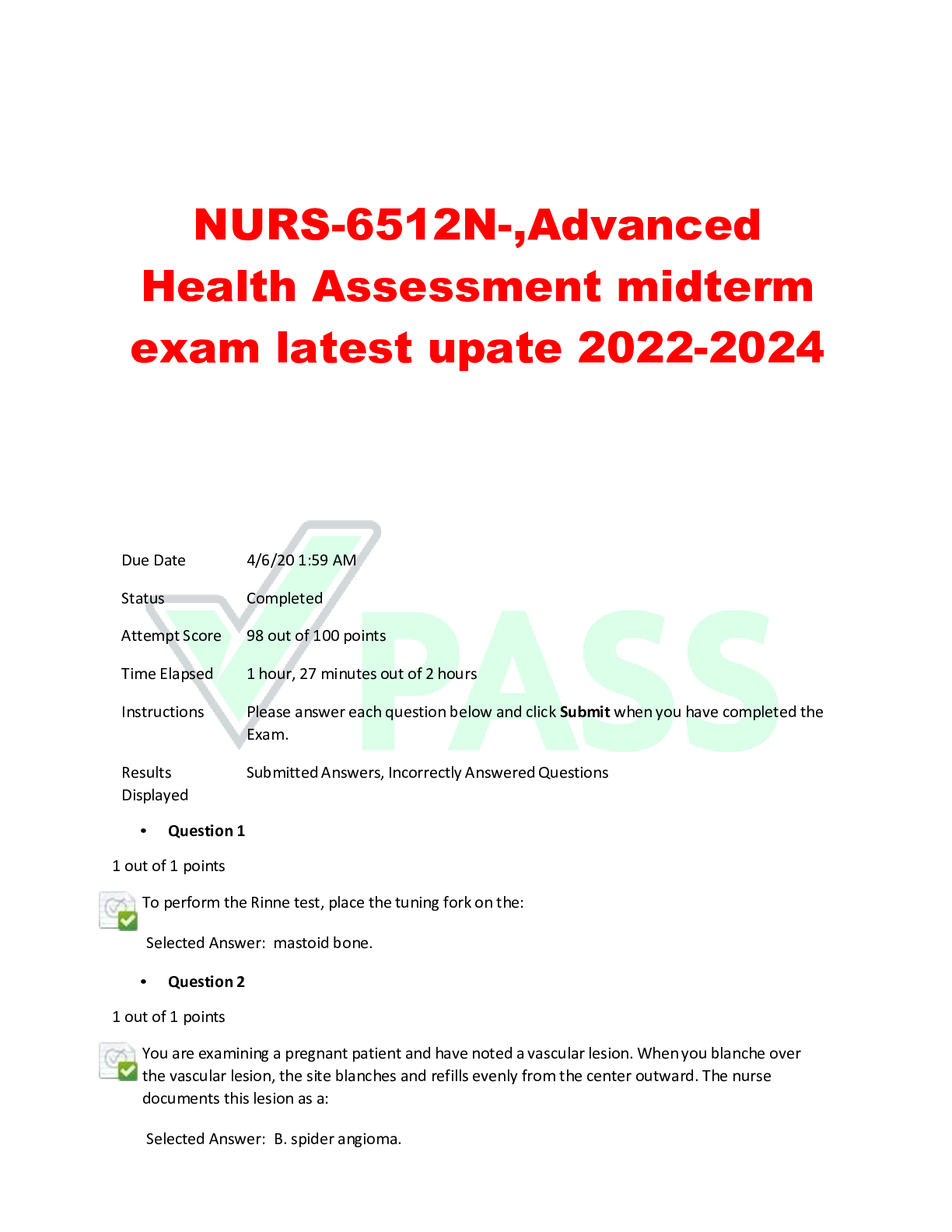
Reviews( 0 )
Document information
Connected school, study & course
About the document
Uploaded On
May 10, 2022
Number of pages
35
Written in
Additional information
This document has been written for:
Uploaded
May 10, 2022
Downloads
0
Views
37

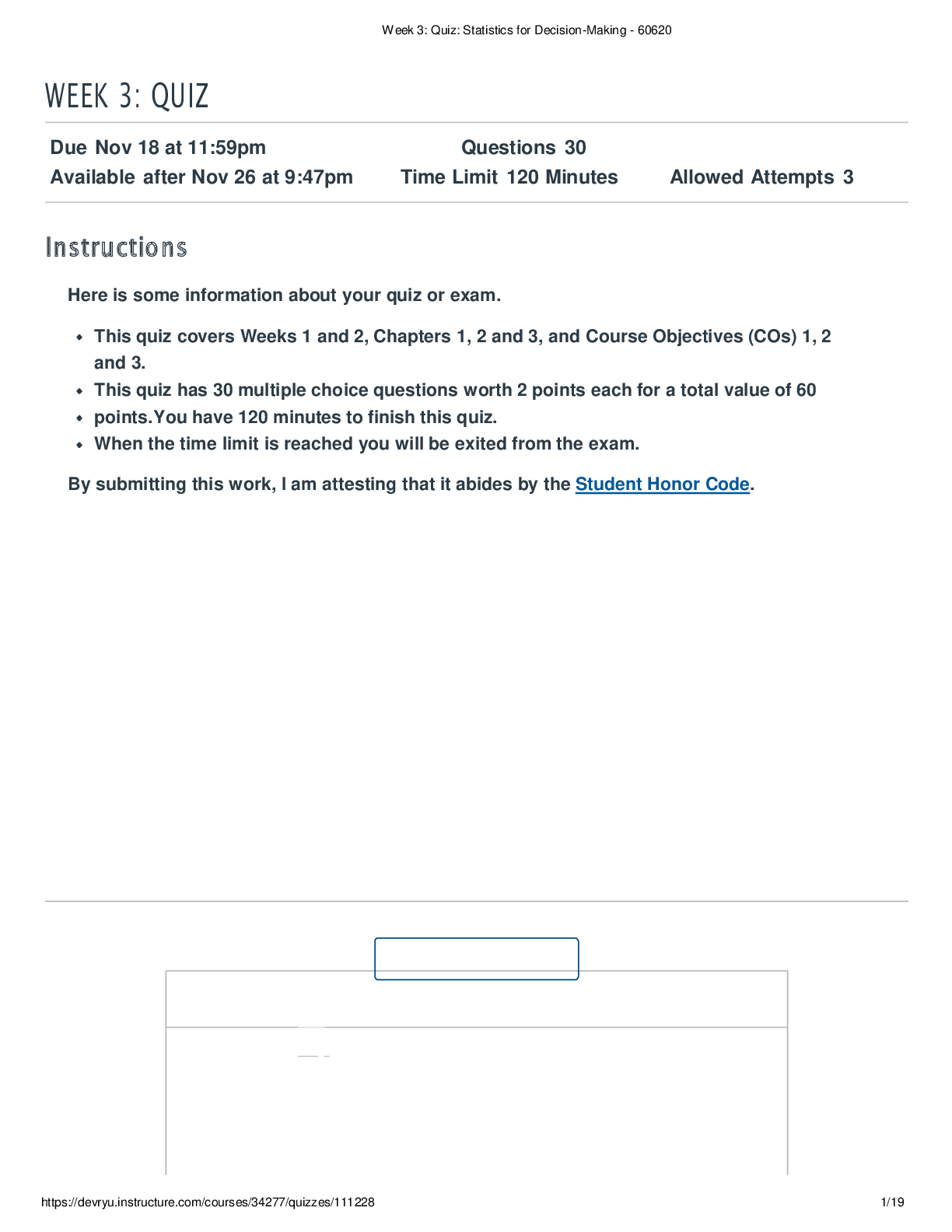

.png)










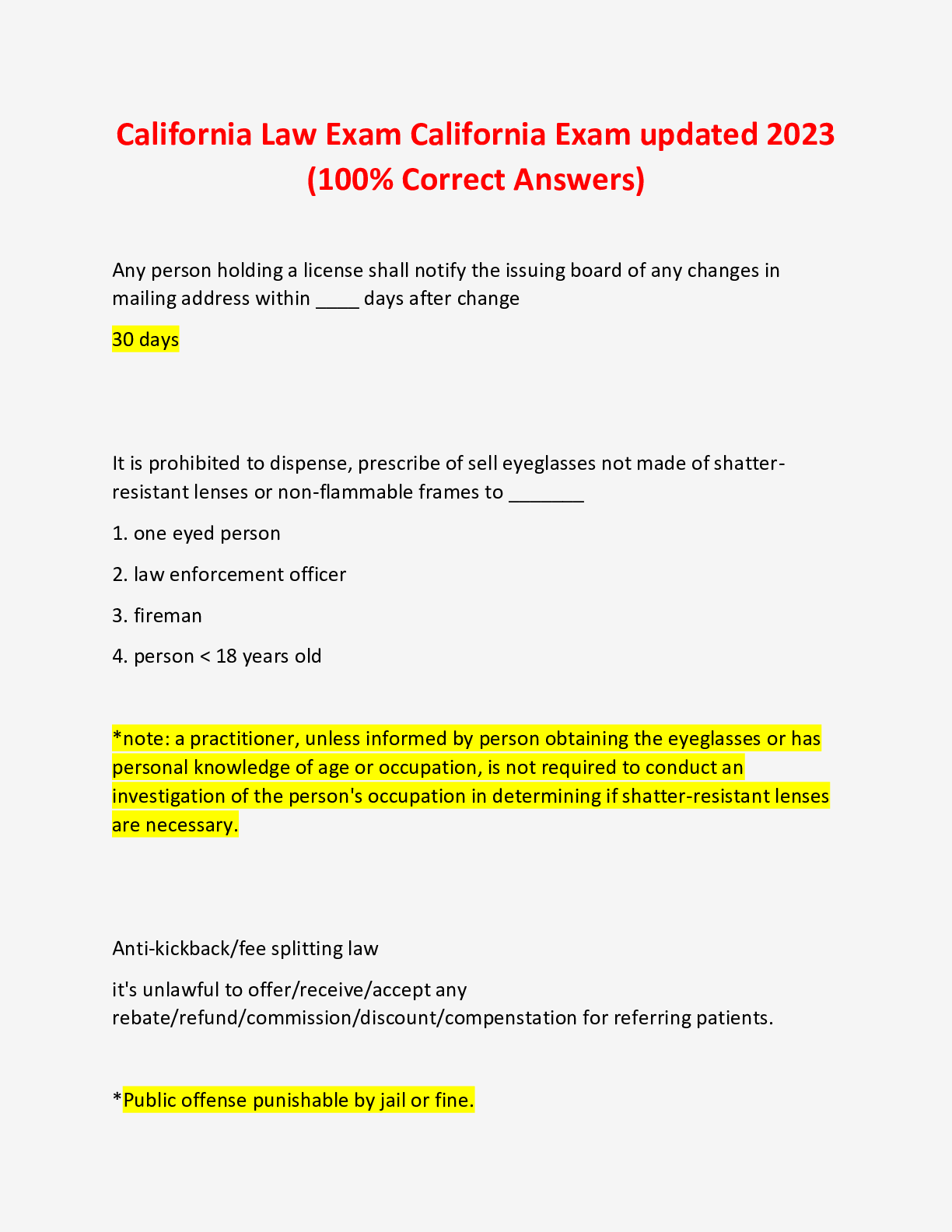


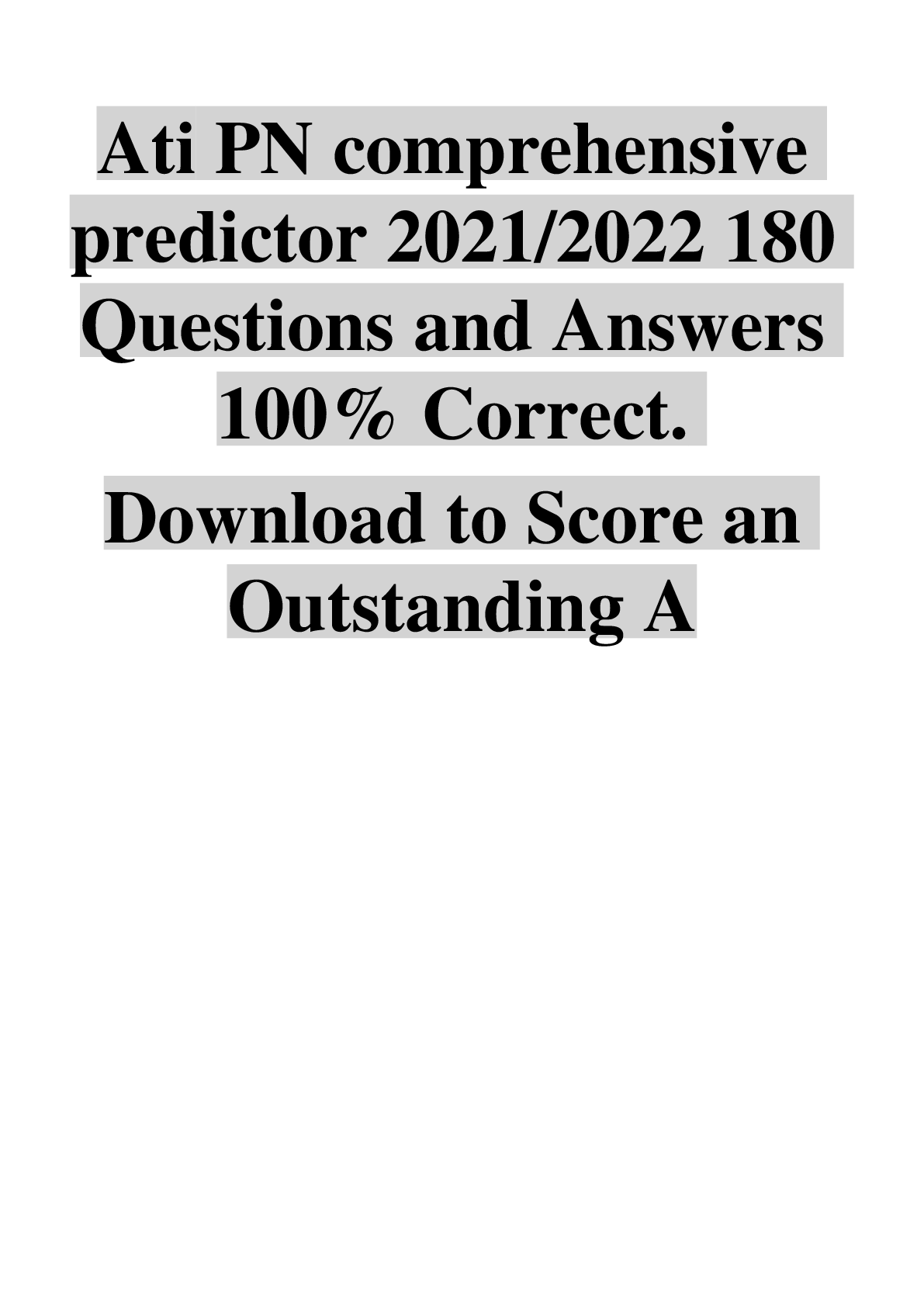

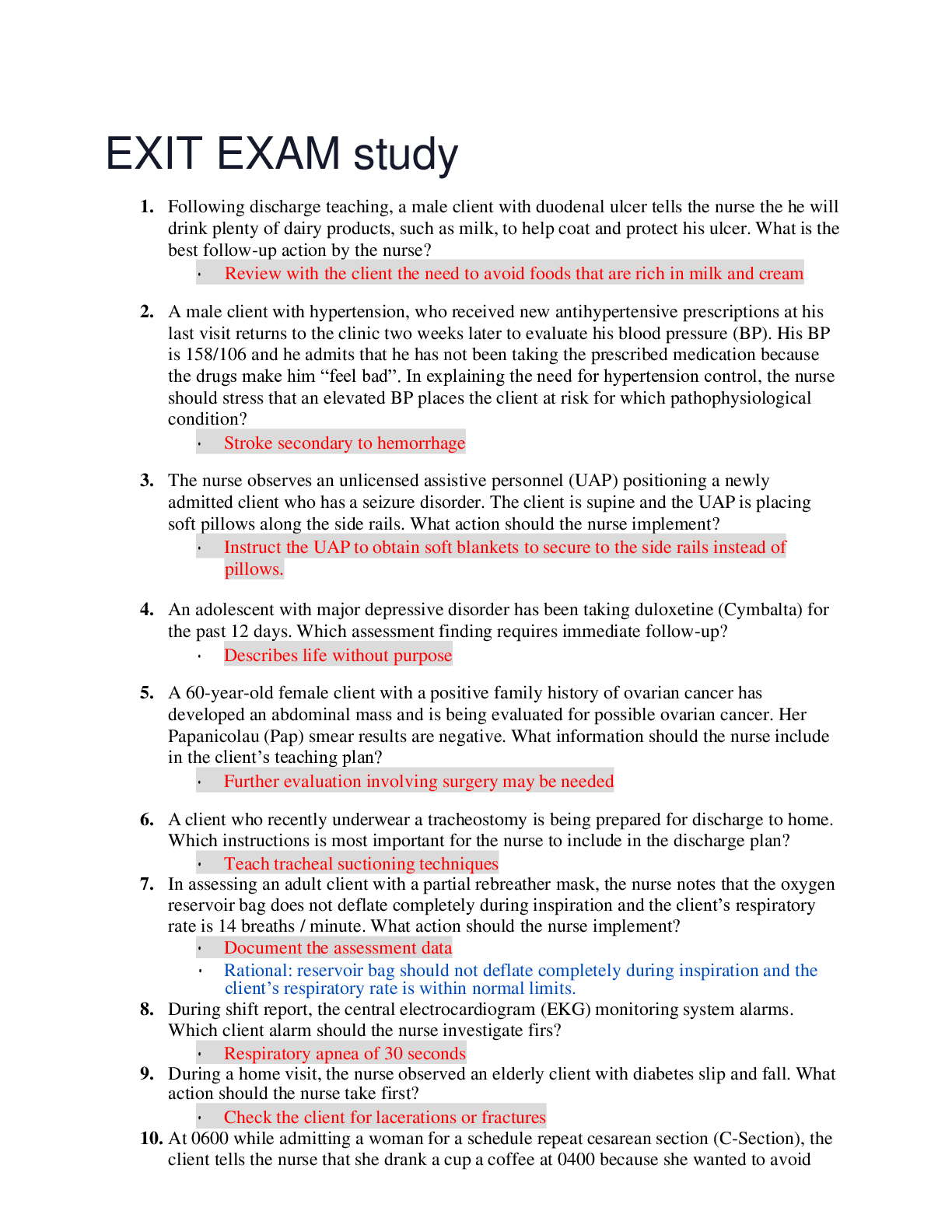
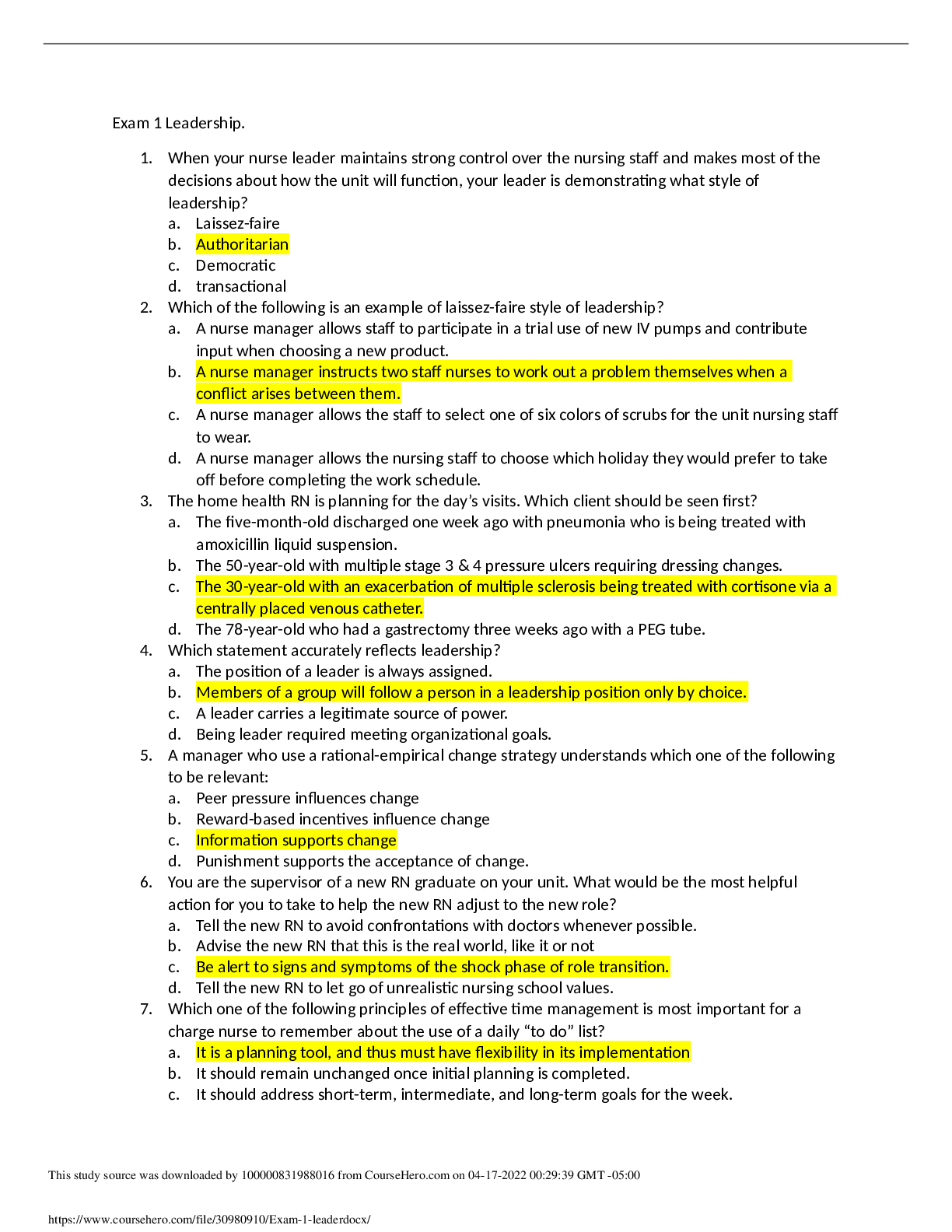
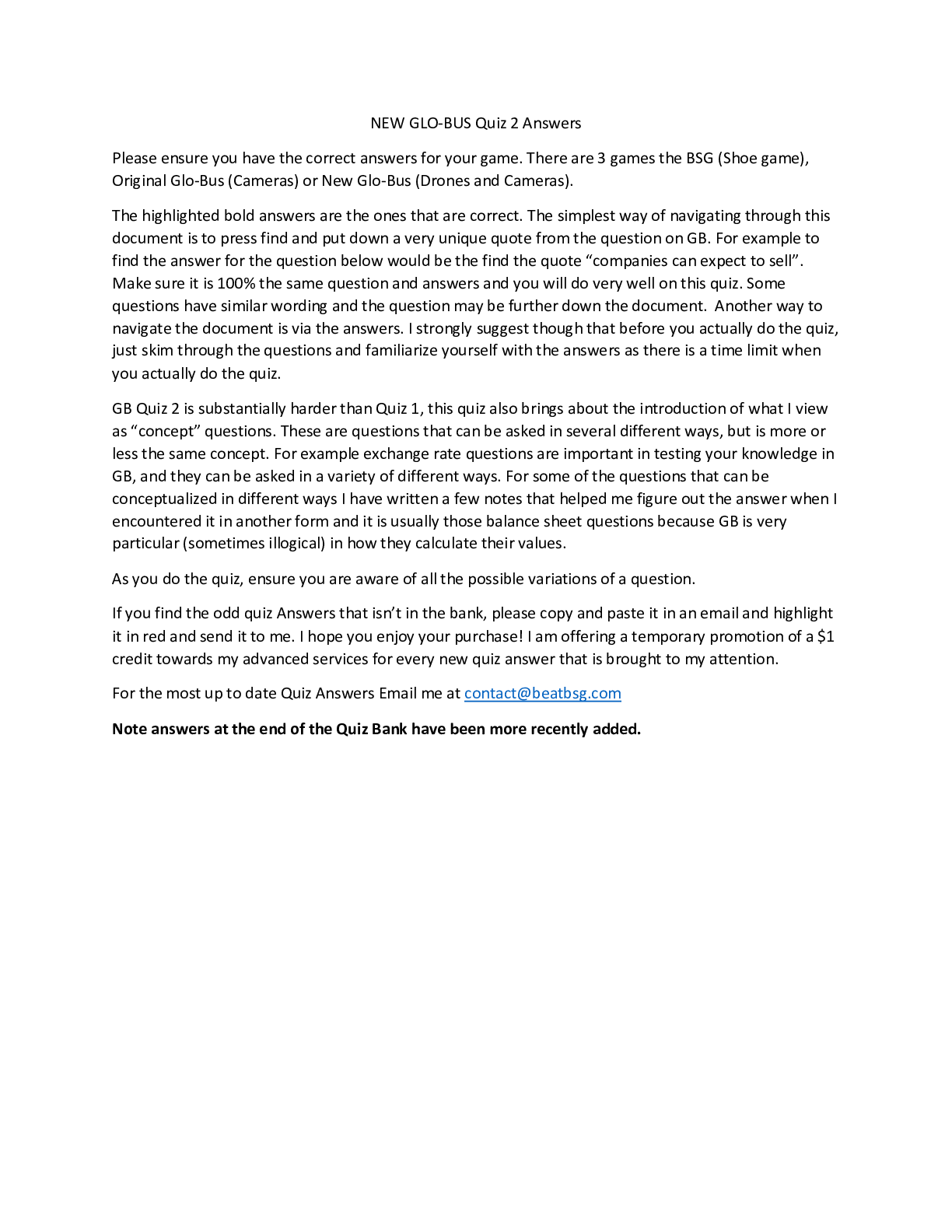
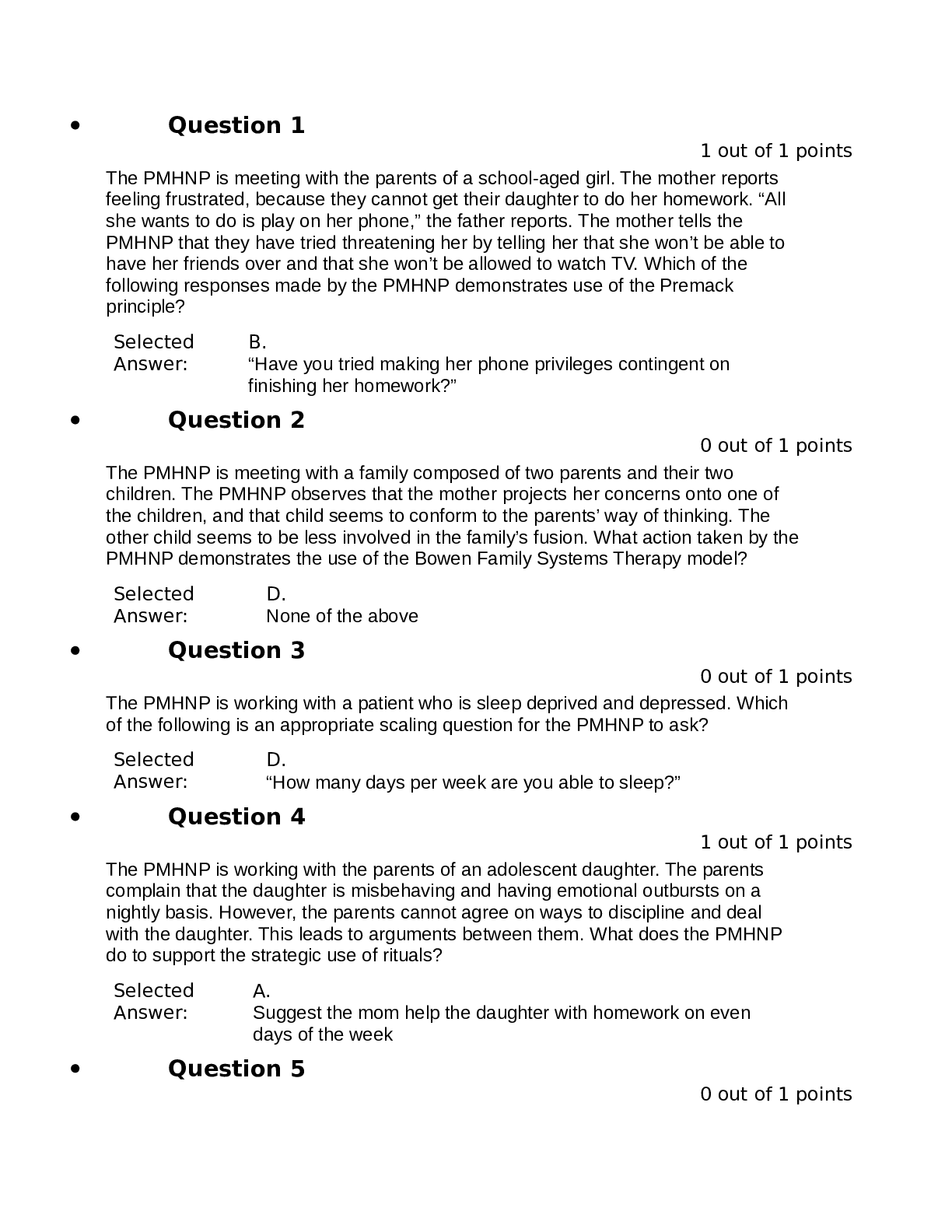
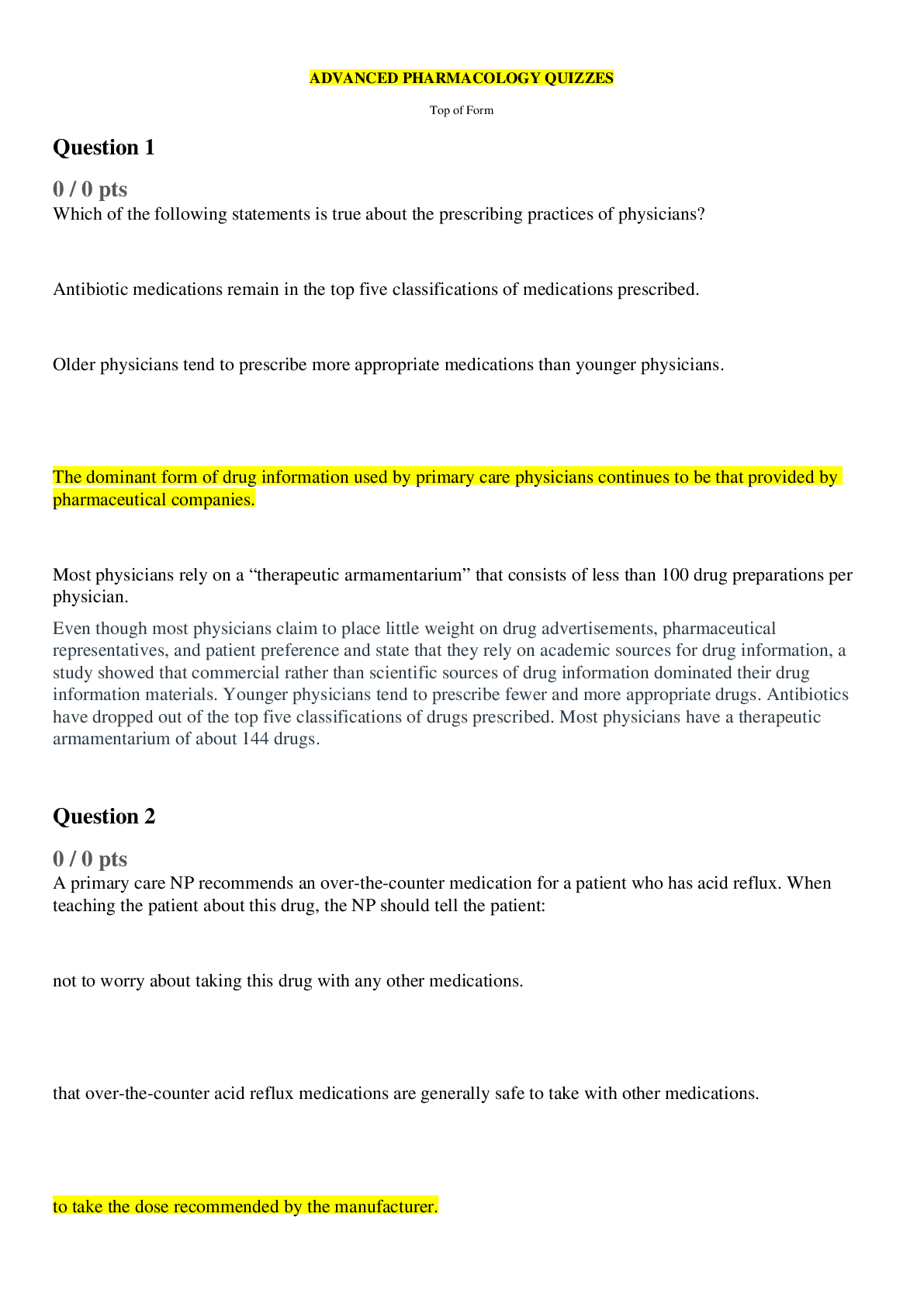
 (1).png)

.png)
